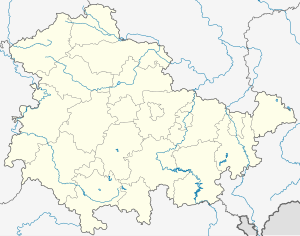Hohenzollern Bridge (Erfurt)
Coordinates: 50 ° 57 ′ 57 ″ N , 11 ° 0 ′ 48 ″ E
| Hohenzollern Bridge | ||
|---|---|---|
| Convicted | Alfred-Hess-Strasse | |
| Subjugated | Gera ( flood ditch ) | |
| place | Erfurt , Thuringia | |
| construction | Arch bridge | |
| width | 13.0 m | |
| Number of openings | 1 | |
| Clear width | 25.10 m | |
| Arrow height | 3.25 m | |
| Arch thickness (vertex) | 0.45 m | |
| construction time | 1911/12 | |
| location | ||
|
|
||
The Hohenzollern Bridge is a road bridge which in Erfurt the Flutgraben of Gera spans. It is the only bridge in the city with artistic sculptures. It is a listed building .
The first plans for a road bridge that crossed the Flutgraben in the course of what was then Hohenzollernstrasse (later Strasse der Einheit, today Alfred-Hess-Strasse) in the Erfurt district of Brühlervorstadt were made in 1898 as part of the development of the Brühler Dreibrunnenfeld. On January 17, 1911, the city council approved the construction of an arch bridge in the shape of a basket arch . The arch with a clear width of 25.1 m and a pitch of 3.25 m has the two-hinged arch as a static system with a transom thickness of 0.65 m and a crown thickness of 0.45 m. The bridge vault was built in 1911 from 230 m³ of stamped concrete . The front walls were clad with facing stones and massive stones made of shell limestone were used for the parapets . At the end of 1912, the Hohenzollern Bridge was completed. The construction costs amounted to 62,000 marks .
Due to the location of the bridge in a residential area, the building received specially designed wing parapets with sculptures made of shell limestone and allegorical figures by the Erfurt sculptor Carl Melville . On the southern side, the figure with a hammer and stone slab symbolize work and the figure sitting with a fruit bowl symbolizes the harvest. On the northern side, the reclining woman with a mirror indicates beauty and the reclining woman with a wine bowl indicates enjoyment. The artistic design was completed in 1913 and cost 10,000 marks.
Extensive repairs were carried out in 1992. The gravel filling on the back of the vault was replaced by concrete.
literature
- Dietrich Baumbach, Hans-Jörg Vockrodt: Historic arch and vault bridges in the city of Erfurt. Habel, Erfurt 2000, ISBN 3-00-006938-0 , pp. 15-18.
Web links
Individual evidence
- ↑ Hans-Jörg Vockrodt, Dietrich Baumbach: Bridges and footbridges in old Erfurt. State capital Erfurt, Erfurt 2004, p. 41.


